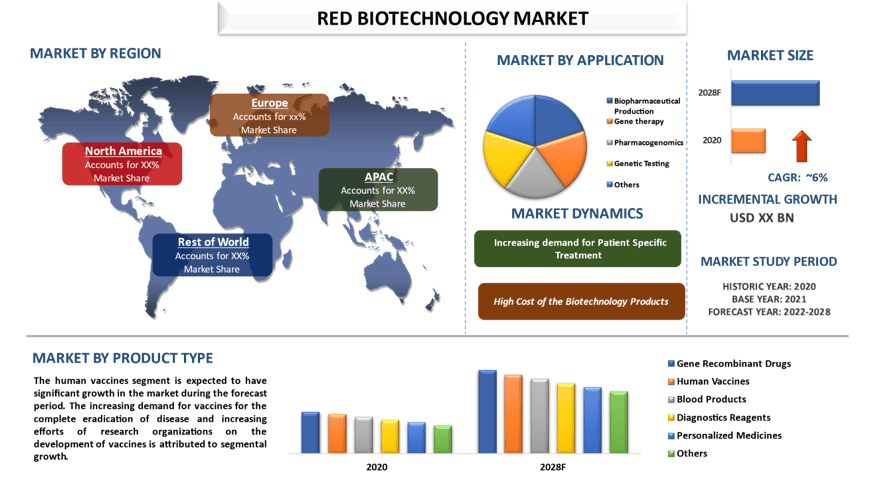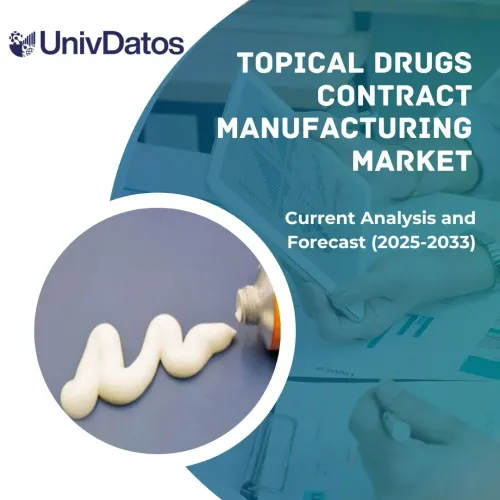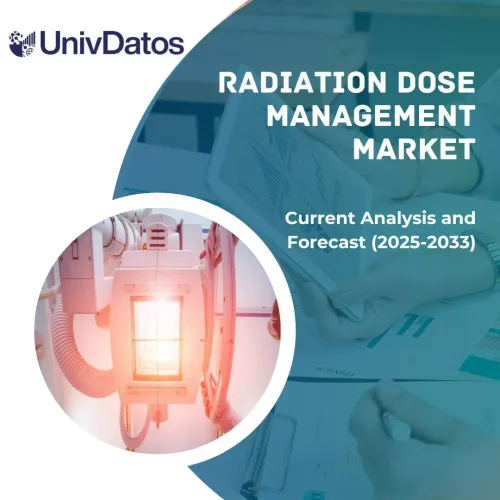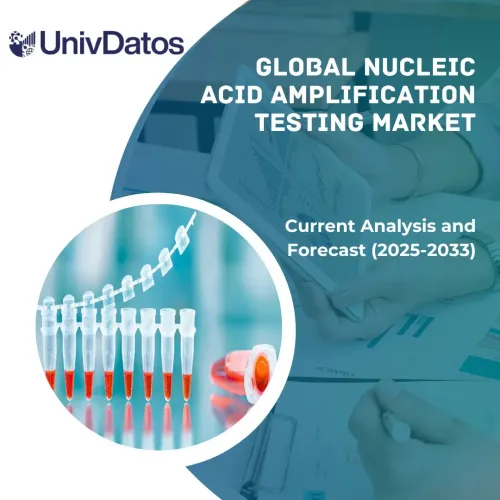- Home
- About Us
- Industry
- Services
- Reading
- Contact Us
Red Biotechnology Market: Current Analysis and Forecast (2022-2028)
Emphasis on Application (Biopharmaceutical Production, Gene Therapy, Pharmacogenomics, Genetic Testing, and Others); Product Type (Gene Recombinant Drugs, Human Vaccines, Blood Products, Diagnostics Reagents, Personalized Medicines, and Others); Region (North America, Europe, Asia-Pacific, Rest of the World); and Region/Country

The global red biotechnology market is expected to grow at a significant rate of around 6% during the forecast period. Biopharmaceuticals are complex medicines made from living cells or organisms, often produced using cutting-edge biotechnological methods. The reliability and safety of biopharmaceutical products along with their ability to treat rare diseases are among the important factors responsible for the market growth of the biopharmaceutical industry. Furthermore, the rising number of orphan diseases, the occurrence of mutation in the viruses, and increasing investments in the biologics industry by government & private organizations are also contributing factors to the market growth of red biotechnology. For instance, in July 2022, vaccine maker Biological E announced its expansion plans for investment of over Rs 1,800 crore.
Pfizer Inc., AstraZeneca Plc, F. Hoffmann-La Roche Ltd, Celgene Corporation, Takeda Pharmaceutical Company Limited, Biogen Inc., Amgen Inc., Gilead Sciences Inc., Merck & Co. Inc., and CSL Limited are some of the key players in the market. Several M&As along with partnerships have been undertaken by these players to facilitate customers with hi-tech and innovative products/technologies.
Insights Presented in the Report
“Amongst Application, pharmacogenomics category to witness higher CAGR during the forecast period”
Based on the application, the market has been categorized into biopharmaceutical production, gene therapy, pharmacogenomics, genetic testing, and others. The pharmacogenomics category is expected to witness a higher CAGR during the forecast period. The rising number of genetic disorders along with the increasing number of autoimmune disorders and the rising biotechnology industry in developing nations is responsible for the segmental growth of pharmacogenomics.
“Amongst Product Type, human vaccines to hold a significant share in the market in 2020”
Based on the product type, the market has been categorized into gene recombinant drugs, human vaccines, blood products, diagnostics reagents, personalized medicines, and others. Among them, the human vaccines segment is expected to have significant growth in the market during the forecast period. The rising government efforts to increase vaccination along with vaccines provide long-term solutions against the disease is attributed to the growth of the market. For instance, as per the national health mission, Universal Immunization Program (UIP) is one of the largest public health programs targeting close of 2.67 crore newborns and 2.9 crore pregnant women annually.
“North America to hold a dominant share in the market”
For a better understanding of the market adoption of the red biotechnology industry, the market is analyzed based on its worldwide presence in the countries such as North America (United States, Canada, and the Rest of North America), Europe (Germany, France, Italy, Spain, United Kingdom and Rest of Europe), Asia-Pacific (China, Japan, India, Australia, and Rest of APAC), and Rest of World. In 2020, North America held a significant share of the global red biotechnology market. This is mainly attributed to the presence of major economies along with the higher R&D investment in the rising biotechnology industry in the region. Furthermore, the launch of various treatment and biopharmaceutical drugs is also an important reason for the considerable growth of the regional growth of the red biotechnology industry. For instance, in June 2021, Jazz Pharmaceuticals plc announced the U.S. Food and Drug Administration (FDA) approval of Rylaze™ for use as a component of a multi-agent chemotherapeutic regimen for the treatment of acute lymphoblastic leukemia (ALL) or lymphoblastic lymphoma (LBL) in pediatric and adult patients who have developed hypersensitivity to E. coli-derived asparaginase.
Reasons to buy this report:
- The study includes market sizing and forecasting analysis validated by authenticated key industry experts.
- The report presents a quick review of overall industry performance at one glance.
- The report covers an in-depth analysis of prominent industry peers with a primary focus on key business financials, product portfolio, expansion strategies, and recent developments.
- Detailed examination of drivers, restraints, key trends, and opportunities prevailing in the industry.
- The study comprehensively covers the market across different segments.
- Deep dive regional level analysis of the industry.
Customization Options:
The global red biotechnology market can further be customized as per the requirement or any other market segment. Besides this, UMI understands that you may have your own business needs, hence feel free to connect with us to get a report that completely suits your requirements.
Table of Content
Research Methodology for the Red Biotechnology Market Analysis (2022-2028)
Analyzing the historical market, estimating the current market, and forecasting the future market of the global red biotechnology market were the three major steps undertaken to create and analyze the adoption of red biotechnology in major regions globally. Exhaustive secondary research was conducted to collect the historical market numbers and estimate the current market size. Secondly, to validate these insights, numerous findings and assumptions were taken into consideration. Moreover, exhaustive primary interviews were also conducted, with industry experts across the value chain of the global red biotechnology market. Post assumption and validation of market numbers through primary interviews, we employed a top-down/bottom-up approach to forecasting the complete market size. Thereafter, market breakdown and data triangulation methods were adopted to estimate and analyze the market size of segments and sub-segments of the industry pertains to. Detailed methodology is explained below:
Analysis of Historical Market Size
Step 1: In-Depth Study of Secondary Sources:
Detail secondary study was conducted to obtain the historical market size of the red biotechnology market through company internal sources such as annual reports & financial statements, performance presentations, press releases, etc., and external sources including journals, news & articles, government publications, competitor publications, sector reports, third-party database, and other credible publications.
Step 2: Market Segmentation:
After obtaining the historical market size of the red biotechnology market, we conducted a detailed secondary analysis to gather historical market insights and share for different segments & sub-segments for major regions. Major segments are included in the report as application and product types. Further country-level analyses were conducted to evaluate the overall adoption of testing models in that region.
Step 3: Factor Analysis:
After acquiring the historical market size of different segments and sub-segments, we conducted a detailed factor analysis to estimate the current market size of the Red Biotechnology market. Further, we conducted factor analysis using dependent and independent variables such as the application and product type of Red biotechnology. A thorough analysis was conducted for demand and supply-side scenarios considering top partnerships, mergers and acquisitions, business expansion, and product launches in the red biotechnology market sector across the globe.
Current Market Size Estimate & Forecast
Current Market Sizing: Based on actionable insights from the above 3 steps, we arrived at the current market size, key players in the global red biotechnology market, and market shares of the segments. All the required percentage shares split, and market breakdowns were determined using the above-mentioned secondary approach and were verified through primary interviews.
Estimation & Forecasting: For market estimation and forecast, weights were assigned to different factors including drivers & trends, restraints, and opportunities available for the stakeholders. After analyzing these factors, relevant forecasting techniques i.e., the top-down/bottom-up approach were applied to arrive at the market forecast for 2028 for different segments and sub-segments across the major markets globally. The research methodology adopted to estimate the market size encompasses:
- The industry’s market size, in terms of revenue (USD) and the adoption rate of the red biotechnology market across the major markets domestically
- All percentage shares, splits, and breakdowns of market segments and sub-segments
- Key players in the global Red Biotechnology market in terms of products offered. Also, the growth strategies adopted by these players to compete in the fast-growing market
Market Size and Share Validation
Primary Research: In-depth interviews were conducted with the Key Opinion Leaders (KOLs) including Top Level Executives (CXO/VPs, Sales Head, Marketing Head, Operational Head, Regional Head, Country Head, etc.) across major regions. Primary research findings were then summarized, and statistical analysis was performed to prove the stated hypothesis. Inputs from primary research were consolidated with secondary findings, hence turning information into actionable insights.
Split of Primary Participants in Different Regions

Market Engineering
The data triangulation technique was employed to complete the overall market estimation and to arrive at precise statistical numbers for each segment and sub-segment of the global red biotechnology market. Data was split into several segments & sub-segments post studying various parameters and trends in the areas of the application and product type in the global red biotechnology market.
The main objective of the Global Red Biotechnology Market Study
The current & future market trends of the global red biotechnology market were pinpointed in the study. Investors can gain strategic insights to base their discretion for investments on the qualitative and quantitative analysis performed in the study. Current and future market trends determined the overall attractiveness of the market at a regional level, providing a platform for the industrial participant to exploit the untapped market to benefit from a first-mover advantage. Other quantitative goals of the studies include:
- Analyze the current and forecast market size of the red biotechnology market in terms of value (USD). Also, analyze the current and forecast market size of different segments and sub-segments
- Segments in the study include areas of application and product type.
- Define and analysis of the regulatory framework for the red biotechnology industry.
- Analyze the value chain involved with the presence of various intermediaries, along with analyzing customer and competitor behaviors of the industry.
- Analyze the current and forecast market size of the red biotechnology market for the major region.
- Major countries of regions studied in the report include Asia Pacific, Europe, North America, and the Rest of the World.
- Company profiles of the red biotechnology market and the growth strategies adopted by the market players to sustain in the fast-growing market
- Deep dive regional level analysis of the industry
Related Reports
Customers who bought this item also bought










